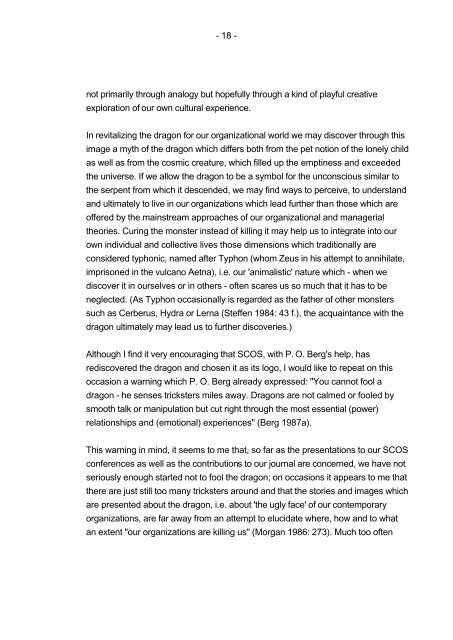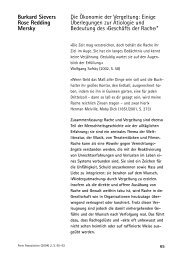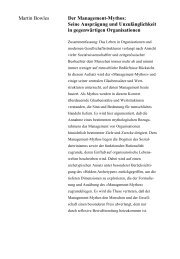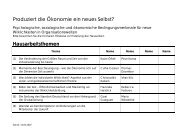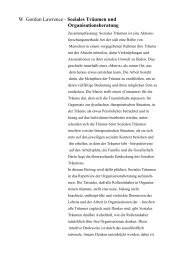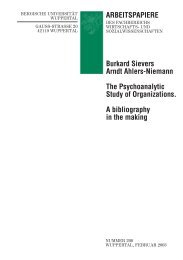Curing the monster Some images of and considerations - Prof. Dr ...
Curing the monster Some images of and considerations - Prof. Dr ...
Curing the monster Some images of and considerations - Prof. Dr ...
Create successful ePaper yourself
Turn your PDF publications into a flip-book with our unique Google optimized e-Paper software.
- 18 -<br />
not primarily through analogy but hopefully through a kind <strong>of</strong> playful creative<br />
exploration <strong>of</strong> our own cultural experience.<br />
In revitalizing <strong>the</strong> dragon for our organizational world we may discover through this<br />
image a myth <strong>of</strong> <strong>the</strong> dragon which differs both from <strong>the</strong> pet notion <strong>of</strong> <strong>the</strong> lonely child<br />
as well as from <strong>the</strong> cosmic creature, which filled up <strong>the</strong> emptiness <strong>and</strong> exceeded<br />
<strong>the</strong> universe. If we allow <strong>the</strong> dragon to be a symbol for <strong>the</strong> unconscious similar to<br />
<strong>the</strong> serpent from which it descended, we may find ways to perceive, to underst<strong>and</strong><br />
<strong>and</strong> ultimately to live in our organizations which lead fur<strong>the</strong>r than those which are<br />
<strong>of</strong>fered by <strong>the</strong> mainstream approaches <strong>of</strong> our organizational <strong>and</strong> managerial<br />
<strong>the</strong>ories. <strong>Curing</strong> <strong>the</strong> <strong>monster</strong> instead <strong>of</strong> killing it may help us to integrate into our<br />
own individual <strong>and</strong> collective lives those dimensions which traditionally are<br />
considered typhonic, named after Typhon (whom Zeus in his attempt to annihilate,<br />
imprisoned in <strong>the</strong> vulcano Aetna), i.e. our 'animalistic' nature which - when we<br />
discover it in ourselves or in o<strong>the</strong>rs - <strong>of</strong>ten scares us so much that it has to be<br />
neglected. (As Typhon occasionally is regarded as <strong>the</strong> fa<strong>the</strong>r <strong>of</strong> o<strong>the</strong>r <strong>monster</strong>s<br />
such as Cerberus, Hydra or Lerna (Steffen 1984: 43 f.), <strong>the</strong> acquaintance with <strong>the</strong><br />
dragon ultimately may lead us to fur<strong>the</strong>r discoveries.)<br />
Although I find it very encouraging that SCOS, with P. O. Berg's help, has<br />
rediscovered <strong>the</strong> dragon <strong>and</strong> chosen it as its logo, I would like to repeat on this<br />
occasion a warning which P. O. Berg already expressed: "You cannot fool a<br />
dragon - he senses tricksters miles away. <strong>Dr</strong>agons are not calmed or fooled by<br />
smooth talk or manipulation but cut right through <strong>the</strong> most essential (power)<br />
relationships <strong>and</strong> (emotional) experiences" (Berg 1987a).<br />
This warning in mind, it seems to me that, so far as <strong>the</strong> presentations to our SCOS<br />
conferences as well as <strong>the</strong> contributions to our journal are concerned, we have not<br />
seriously enough started not to fool <strong>the</strong> dragon; on occasions it appears to me that<br />
<strong>the</strong>re are just still too many tricksters around <strong>and</strong> that <strong>the</strong> stories <strong>and</strong> <strong>images</strong> which<br />
are presented about <strong>the</strong> dragon, i.e. about '<strong>the</strong> ugly face' <strong>of</strong> our contemporary<br />
organizations, are far away from an attempt to elucidate where, how <strong>and</strong> to what<br />
an extent "our organizations are killing us" (Morgan 1986: 273). Much too <strong>of</strong>ten


